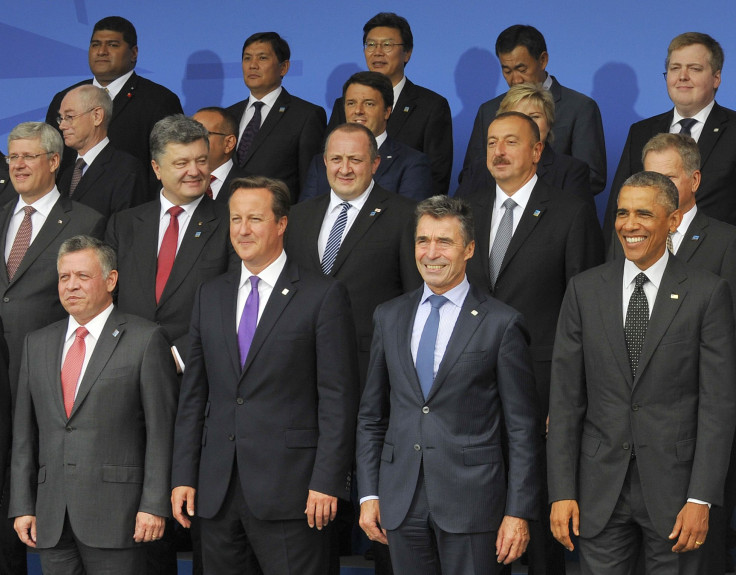Obama Wants More NATO Defense Spending To Deal With Ukraine And ISIS, But Reality Says Otherwise

U.S. President Barack Obama reiterated to allies at the NATO summit in Wales on Thursday that they must spend more on defense if the alliance is to be effective against threats like a resurgent Russia and the Islamic militant group ISIS. But most of America’s allies in the 28-member alliance don’t spend the 2 percent of GDP that Obama has said is the target. In fact, only seven countries meet the goal.
In a Europe that has been through five years of weak economic recovery, and with several nations dealing with persistent recession and high unemployment, even those seven countries might find it difficult to sustain that level of spending. For the rest, according to experts, the target will be difficult to reach anytime soon.
“It’s not a realistic target for many of the NATO countries,” said Samuel Perlo-Freeman, senior researcher at the Stockholm International Peace Research Institute. “Many of the those countries, especially in Europe, are still implementing austerity programs.”
Obama first made reference to NATO members’ military spending as he addressed delegates at an event in Estonia on Wednesday, saying, “We need to keep our alliance strong for the future. And that means investing in the capabilities, like intelligence and surveillance and reconnaissance and missile defense.”
Over the last decade, according to SIPRI figures, many NATO members have been cutting back rather than increasing defense spending, with the U.S. often picking up the slack on NATO missions, including the soon-to-end 13-year conflict in Afghanistan.
By 2013 levels, only the United States, Estonia, France, Greece, Portugal, Turkey and the U.K. spend over 2 percent. The rest vary as low as Luxembourg’s 0.5 percent and Hungary’s 0.9 percent up to Poland’s 1.8 percent, and for many spending is coming down, not up.
Since 2008, only eight countries have increased military spending, and only by a few percentage points. The current trend has been one for cutbacks.
The U.S. itself, for example, has cut back from a peak of 4.8 percent in 2009 to 3.8 percent of its gross domestic product spent on defense in 2013, which represents a difference of almost $100 billion.
The U.S. will always likely be above the 2 percent line because of its military role around the world. But asking allies to reach that 2 percent marker, said Perlo-Freeman, doesn’t meet the needs of many NATO members.
“It’s an arbitrary figure that’s been plucked out of the air. If a country’s GDP increases a lot, does it mean its security needs suddenly increase a lot in proportion?” he said. “Increasing military spending to 2 percent of GDP would either mean very large tax rises or substantial cuts in other areas of public spending, and in nearly all of those countries there’s not going to be any political will to do this, or popular support.”
As the NATO mission ends in Afghanistan, threats to the alliance are rising in the form of Russia and ISIS. Those, said Ivo Daalder, former U.S. permanent representative to NATO and president of the Chicago Council on Global Affairs, are reasons to get military spending up across all NATO countries.
“There is a very real need for investment from the Europeans,” Daalder said during a conference call hosted by the Council on Foreign Relations. “Two percent is a target that has been around for more than a decade and it is not terribly large compared to what many countries, including Russia, are spending on defense, or even the U.S., but no one expects this to happen overnight.”
However, getting to that 2 percent marker, for example, would cost countries like Belgium, which spends 1 percent on defense, around $5.08 billion extra every year at its current GDP level. That money would have to come from cuts in other areas of government spending or from an increase in taxes, Perlo-Freeman said.
To put those European problems into a real context, France, which spent last year $57 billion (2.2 percent) of its $2.6 trillion economy on defense, is grappling with the problem of how to absorb the $1.6 billion cost of two warships that it built for Russia, but whose sale it halted because of pressure from other governments and public outrage against Russia in the wake of the Ukrainian conflict.
Despite the difficulties that Perlo-Freeman envisages, some NATO members have agreed to reach that target. Latvia and Lithuania, which spend 0.8 percent and 1 percent, respectively, have agreed to meet the goal by the end of the decade. Romania, which spends 1.3 percent of its GDP, has said it will reach 2 percent in the next four years, at a cost of around $1.3 billion.
But they are Russia's neighbors, with a special concern about the actions of the world's largest country, and newly aggressive nuclear power, next door. In the case of the three Baltic countries -- Estonia, Latvia, Lithuania -- they also have regained their independence only two decades ago, after bitterly resented Soviet rule.
“The Baltics,” said Perlo-Freeman, “are a bit of a different case.”
© Copyright IBTimes 2025. All rights reserved.






















